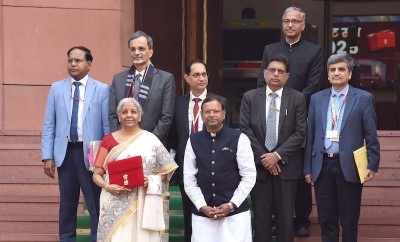Economy needs to grow at 7 per cent in the next three quarters: Dr C. Rangarajan
On the second quarter GDP growth, Dr Rangarajan said, “some of the reasons for slowdown are temporary or transient factors like introduction of GST or perhaps even demonetisation. Therefore, I believe that if you look at it, the fourth quarter and the first quarter have been more or less same-5.6% and 5.7%," he said.
"To me it looks, it bottomed out. Now it will pick up”, said Dr C. Rangarajan, Former Chairman-Economic Advisory Council to the Prime Minister of India & Former Governor, RBI said while inaugurating an ASSOCHAM 10th International Gold Summit here at New Delhi.
‘But even to get 6.5% for the year as a whole, the economy needs to grow at 7% in the next three quarters. So my own estimate is that for the year as a whole, probably the rate of growth will be 6.5%’.
On recapitalisation bond, Dr Rangarajan said ‘banking system needs to be recapitalised’. In early 1990s, we gave money to banks but they were asked to invest it in bonds. What is an important, bank should be recapitalised so that they can provide additional credit.
The government is planning to come out with some kind of stimulus, he said, the fall in the growth rate is also accompanied by fall in investment rate and more critically, it is private investment rate that is falling. In fact, the public investment rate, or public expenditure on capital, has shown some slight rise, said former RBI governor.
Therefore, the most important thing to address is the problem that may be preventing private investment from rising. Therefore, the package in my opinion should be partly to raise capital expenditure of the government but suited in a way that is stimulus private expenditure as well.
Dr C. Rangarajan also point out that there have been a number of stalled projects. And the low hanging fruit is to ensure these stalled projects are activated, such as those stalled projects viable must be immediately made operational.
On the demonetisation, he said, ‘What comes out it that had authorities been prepared, the result would have different? If authorities had enough supply of currency at the time when demonetisation was announced, much of the problem that people had experienced would not have been there. Therefore, the pain that draw into cost was essentially because of inadequate preparations for the scheme, said Dr Rangarajan.
On the Goods & Services Tax (GST), Dr C. Rangarajan said that GST is a good measure. Whenever it is introduce, there have always been initial problems. It is major step in the tax reform in the country. I do not think the government should delay it at all.
Dr Rangarajan further said, to contain import of gold through quantitative restrictions will not work. It can also only lead to smuggling with all the associated evils. Tastes do not change easily. We must understand the fact that gold is an attractive form of asset for Indians. Gold jewellery has become part of the cultural ethos. It however also serves as an asset which can come to the help of the people in times of need and distress. Gold monetization schemes, if pursued vigourously can lead to a better utilisation of existing stock of gold. For this, the procedures need to be simplified. Under these schemes, gold which would have otherwise remained idle also earns a return.
Perhaps, temples and other institutions which have a large quantity of gold are the appropriate clients for this kind of schemes. The attempt to mobilise privately held gold stocks and transfer them into the hands of financial institutions could at least meet to some extent the demand for gold jewellery. We could avoid the use of gold as a hedge against inflation if we can offer suitable financial substitutes. In order to succeed in containing the demand for gold, we must act on ensuring that the financial products give an adequate return. Financial products in this context should cover a wide range from banking deposits to mutual fund products.
Demand for gold depends on multiple factors such as income, taste and custom, return on gold, inflation and return on financial products. While efforts must be made to reduce the basic attraction of gold to the people in India, at least, in the short run, we can start acting to reduce the demand for gold as an asset. Taming inflation and enhancing the real rate of return on financial products are fundamental pre-requisites for containing gold demand in India, said Dr Rangarajan.
Mr Manoj Kumar Dwivedi, Joint Secretary, Ministry of Commerce and Industry said, we are looking forward to transforming Indian gold market. The government wants gold industry to be more transparent enhances value addition based exports to generate employment.
Mr Somasundaram P.R., Managing Director – India, World Gold Council said, we have been importing 900 tonnes of gold a year. India has stock of 24,000 tonnes of gold valued at $1 trillion. If we include gold available with banks, value goes up to $1 trillion. Industry has gone through fast-paced changes and we cannot set the clock bank. We have to sit with the government to see what gold can do for India.
Support Our Journalism
We cannot do without you.. your contribution supports unbiased journalism
IBNS is not driven by any ism- not wokeism, not racism, not skewed secularism, not hyper right-wing or left liberal ideals, nor by any hardline religious beliefs or hyper nationalism. We want to serve you good old objective news, as they are. We do not judge or preach. We let people decide for themselves. We only try to present factual and well-sourced news.







